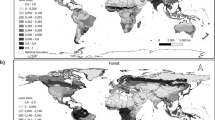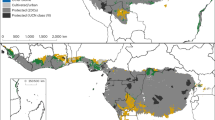Abstract
Cropland expansion represents an important cause of tropical deforestation, contributing to the loss of ecosystems’ functions. Flex-crops (for example, oil palm, soy and sugar cane) account for an increasing share of cropland and contribute considerably to carbon emissions and biodiversity loss. Various forms of inequality have been shown to affect agricultural expansion, yet the effect of wealth concentration among the super-rich is understudied. Here I show how, over the period 1991–2014, the large amount of wealth in the hands of high-net-worth individuals (HNWI) stimulated foreign direct investments in agriculture in Latin America and Southeast Asia. This, in turn, drove the expansion of flex-crops areas. The combination of these two effects implies that a 1% increase in the wealth of HNWI generated an expansion of the flex-crops area share of up to 2.4–10%. The results point to the urgency of addressing wealth inequality to protect the remaining forests.
This is a preview of subscription content, access via your institution
Access options
Access Nature and 54 other Nature Portfolio journals
Get Nature+, our best-value online-access subscription
$29.99 / 30 days
cancel any time
Subscribe to this journal
Receive 12 digital issues and online access to articles
$119.00 per year
only $9.92 per issue
Buy this article
- Purchase on Springer Link
- Instant access to full article PDF
Prices may be subject to local taxes which are calculated during checkout


Similar content being viewed by others
Data availability
All the data were sourced from public databases. The datasets used in the analysis, alongside the Stata code, have been deposited on a publicly accessible repository and are freely available (https://doi.org/10.5061/dryad.xsj3tx9bc).
Code availability
The Stata code for the econometric analysis and the data used are freely accessible (https://doi.org/10.5061/dryad.xsj3tx9bc).
References
Aide, T. M. et al. Deforestation and reforestation of Latin America and the Caribbean (2001–2010). Biotropica 45, 262–271 (2013).
Bustamante, M. M. C. et al. Toward an integrated monitoring framework to assess the effects of tropical forest degradation and recovery on carbon stocks and biodiversity. Glob. Change Biol. 22, 92–109 (2016).
Kehoe, L. et al. Biodiversity at risk under future cropland expansion and intensification. Nat. Ecol. Evol. 1, 1129 (2017).
Haddad, N. M. et al. Habitat fragmentation and its lasting impact on Earth’s ecosystems. Sci. Adv. 1, e1500052 (2015).
World Population Prospects 2019: Ten Key Findings (United Nations, 2019).
Fukase, E. & Martin, W. J. Economic Growth, Convergence, and World Food Demand and Supply (The World Bank, 2017); https://go.nature.com/2twPUQ5
Henders, S., Persson, U. M. & Kastner, T. Trading forests: land-use change and carbon emissions embodied in production and exports of forest-risk commodities. Environ. Res. Lett. 10, 125012 (2015).
Borras, S. M., Franco, J. C., Isakson, S. R., Levidow, L. & Vervest, P. The rise of flex crops and commodities: implications for research. J. Peasant Stud. 43, 93–115 (2016).
Pendrill, F. et al. Agricultural and forestry trade drives large share of tropical deforestation emissions. Glob. Environ. Change 56, 1–10 (2019).
Ceddia, M. G. The impact of income, land, and wealth inequality on agricultural expansion in Latin America. Proc. Natl Acad. Sci. USA 116, 2527–2532 (2019).
Boyce, J. K., Klemer, A. R., Templet, P. H. & Willis, C. E. Power distribution, the environment, and public health: a state-level analysis. Ecol. Econ. 29, 127–140 (1999).
Sant’Anna, A. A. Land inequality and deforestation in the Brazilian Amazon. Environ. Dev. Econ. 22, 1–25 (2017).
Andersson, K. & Agrawal, A. Inequalities, institutions, and forest commons. Glob. Environ. Change 21, 866–875 (2011).
World Inequality Report 2018 (The World Inequality Lab, 2018); http://wir2018.wid.world/contents.html
Galbraith, J. K. Inequality and Instability: A Study of the World Economy Just Before the Great Crisis (Oxford Univ. Press, 2012).
Otto, I. M., Kim, K. M., Dubrovsky, N. & Lucht, W. Shift the focus from the super-poor to the super-rich. Nat. Clim. Change 9, 82–84 (2019).
Cotula, L. The international political economy of the global land rush: a critical appraisal of trends, scale, geography and drivers. J. Peasant Stud. 39, 649–680 (2012).
Lysandrou, P. Global inequality as one of the root causes of the financial crisis: a suggested explanation. Econ. Soc. 40, 323–344 (2011).
Private Financial Sector Investment in Farmland and Agricultural Infrastructure (HighQuest Partners, 2010); https://go.nature.com/31toE1f
De Los Reyes, J. & Sandwell, K. (eds) Flex Crops: a Primer (Transnational Institute, 2018).
Görgen, M. et al. Foreign Direct Investment (FDI) in Land in Developing Countries (Deutsche Geselschafft für Technische Zusammenarbeit, 2010).
Arias, P., Hallam, D., Koroma, S. & Liu, P. Trends and Impact of Foreign Investment in Developing Country Agriculture: Evidence From Case Studies (FAO, 2013).
World Investment Report 2009: Transnational Corporation, Agricultural Production and Development (UNCTAD, 2009); https://go.nature.com/39b5lMO
Piketty, T. & Zucman, G. Capital is back: wealth-income ratios in rich countries 1700–2010. Q. J. Econ. 129, 1255–1310 (2014).
Liargovas, P. G. & Skandalis, K. S. Foreign direct investment and trade openness: the case of developing economies. Soc. Indic. Res. 106, 323–331 (2012).
Sabir, S., Rafique, A. & Abbas, K. Institutions and FDI: evidence from developed and developing countries. Financ. Innov. 5, 8 (2019).
Addison, T. & Heshmati, A. The New Global Determinants of FDI Flows to Developing Countries: The Importance of ICT and Democratization (UNU-WIDER, 2003).
Luyt, I., Santos, N. & Carita, A. Emerging Investment Trends in Primary Agriculture (FAO, 2013).
Tomei, J. & Helliwell, R. Food versus fuel? Going beyond biofuels. Land Use Policy 56, 320–326 (2016).
Richards, P. & Arima, E. Capital surpluses in the farming sector and agricultural expansion in Brazil. Environ. Res. Lett. 13, 075011 (2018).
The State of Food and Agriculture—Investing in Agriculture for a Better Future (FAO, 2012).
Lopez-Carr, D., Barbieri, A., Pan, W. & Iravani, H. in Agriculture and Climate beyond 2015 - A New Perspective on Future Land Use Patterns (eds Brouwer, F. & McCarl, B.A.) 91–107 (Springer, 2006).
Verburg, R. et al. The impact of commodity price and conservation policy scenarios on deforestation and agricultural land use in a frontier area within the Amazon. Land Use Policy 37, 14–26 (2014).
von Braum, J. & Meinzen-Dick, R. “Land Grabbing” by Foreign Investors in Developing Countries: Risks and Opportunities (IFPRI, 2009).
Borras, S. M., Kay, C., Gómez, S. & Wilkinson, J. Land grabbing and global capitalist accumulation: key features in Latin America. Can. J. Dev. Stud. 33, 402–416 (2012).
Meijaard, E. et al. Oil Palm and Biodiversity (IUCN, 2018).
Galaz, V., Crona, B., Dauriach, A., Scholtens, B. & Steffen, W. Finance and the Earth system—exploring the links between financial actors and non-linear changes in the climate system. Glob. Environ. Change 53, 296–302 (2018).
World Wealth Report 2014 (Cap Gemini & Merrill Lynch, 2015).
Asset Management Report 2015 (EFAMA, 2015).
Dicken, P. Global Shift: Mapping the Changing Contours of the World Economy (Guilford Press, 2011).
Fairbairn, M. ‘Like gold with yield’: evolving intersections between farmland and finance. J. Peasant Stud. 41, 777–795 (2014).
Goda, T., Stewart, C. & Torres García, A. Absolute income inequality and rising house prices. Socioecon. Rev. https://doi.org/10.1093/ser/mwz028 (2019).
Harvey, D. The Limits to Capital (Verso, 1999).
Marx, K. Capital: A Critique of Political Economy Vol. 3 (Penguin Classic, 1990).
Marx, K. Capital: A Critique of Political Economy Vol. 1 (Penguin Classic, 1990).
George, H. Progress and Poverty (Cosimo, 2006).
Kalkuhl, M. et al. Can land taxes foster sustainable development? An assessment of fiscal, distributional and implementation issues. Land Use Policy 78, 338–352 (2018).
Khan, M. H. Agricultural taxation in developing countries: a survey of issues and policy. Agric. Econ. 24, 315–328 (2001).
Dye, R. F. & England, R. W. Assessing the Theory and Practice of Land Value Taxation (Lincoln Institute of Land Policy, 2010).
The Development Dimension of FDI: Policy and Rule-making Perspectives (UNCTAD, 2003); https://unctad.org/en/docs/iteiia20034_en.pdf
Wooldridge, J. M. Econometric Analysis of Cross Section and Panel Data (MIT Press, 2010).
Baltagi, B. H. Econometric Analysis of Panel Data (Wiley, 2005).
Barrett, C. B., Gibson, C. C., Hoffman, B. & McCubbins, M. D. The complex links between governance and biodiversity. Conserv. Biol. 20, 1358–1366 (2006).
World Wealth Report 1999 (Merrill Lynch & Gemini Consulting, 2000).
World Wealth Report 2000 (Merrill Lynch & Gemini Consulting, 2001).
World Wealth Report 2001 (Merrill Lynch & Cap Gemini Ernst & Young, 2002).
World Wealth Report 2002 (Merrill Lynch & Cap Gemini Ernst & Young, 2003).
World Wealth Report 2003 (Merrill Lynch & Cap Gemini Ernst & Young, 2004).
World Wealth Report 2004 (Cap Gemini & Merrill Lynch, 2005).
World Wealth Report 2005 (Cap Gemini & Merrill Lynch, 2006).
World Wealth Report 2006 (Cap Gemini & Merrill Lynch, 2007).
World Wealth Report 2007 (Cap Gemini & Merrill Lynch, 2008).
World Wealth Report 2008 (Cap Gemini & Merrill Lynch, 2009).
World Wealth Report 2009 (Cap Gemini & Merrill Lynch, 2010).
World Wealth Report 2010 (Cap Gemini & Merrill Lynch, 2011).
World Wealth Report 2011 (Cap Gemini & Merrill Lynch, 2012).
World Wealth Report 2012 (Cap Gemini & Merrill Lynch, 2013).
World Wealth Report 2013 (Cap Gemini & Merrill Lynch, 2014).
Roodman, D. How to do xtabond2: an introduction to difference and system GMM in Stata. Stata J. 9, 86–136 (2009).
Nickell, S. Biases in dynamic models with fixed effects. Econometrica 49, 1417–1426 (1981).
Acknowledgements
The author acknowledges the core funding provided by the European Research Council under the European Union’s Horizon 2020 research and innovation programme (grant no. INCLUDE 681518).
Author information
Authors and Affiliations
Corresponding author
Ethics declarations
Competing interests
The author declares no competing interests.
Additional information
Publisher’s note Springer Nature remains neutral with regard to jurisdictional claims in published maps and institutional affiliations.
Supplementary information
Supplementary Information
Supplementary results, Tables 1–25 and Figs. 1–5.
Rights and permissions
About this article
Cite this article
Ceddia, M.G. The super-rich and cropland expansion via direct investments in agriculture. Nat Sustain 3, 312–318 (2020). https://doi.org/10.1038/s41893-020-0480-2
Received:
Accepted:
Published:
Issue Date:
DOI: https://doi.org/10.1038/s41893-020-0480-2
This article is cited by
-
Inequality can double the energy required to secure universal decent living
Nature Communications (2022)
-
Impacts of poverty alleviation on national and global carbon emissions
Nature Sustainability (2022)
-
The dialectics of capital: learning from Gran Chaco
Sustainability Science (2022)
-
Extent, intensity and drivers of mammal defaunation: a continental-scale analysis across the Neotropics
Scientific Reports (2020)



